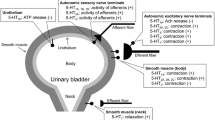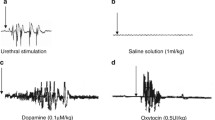Abstract
The aminotetralin 8-hydroxy-2-(di-n-propylamino)tetralin (8-OH-DPAT), pharmacologically characterized as a 5-HT1A receptor agonist, produces a pronounced decrease in ejaculation latency in the male rat. Stimulation of 5-HT receptors by a pharmacologically induced increase in the synaptic availability of 5-HT has been shown to produce the opposite effect. The 8-OH-DPAT-induced decrease in ejaculation latency is specific for this compound, and some chemically related ergot derivatives. In this paper we review the evidence in support for stimulation of serotonergic auto-receptors of the 5-HT1A receptor subtype as a mechanism of action for effects by 8-OH-DPAT on male rat ejaculatory behavior. We also present the questions posed by the fact that quinpirole and lisuride both produce 8-OH-DPAT-like effects on male rat ejaculatory behavior. The effects by quinpirole, lisuride or 8-OH-DPAT are not sensitive to pretreatment with the DA D2/3 receptor antagonist raclopride. Continued studies will show whether the effects of quinpirole and lisuride can be related to stimulation of 5-HT1A receptors, or if all these compounds have as yet undefined common properties.
Similar content being viewed by others
REFERENCES
Ahlenius, S., and Larsson, K. 1991. Physiological and pharmacological implications of specific effects by 5-HT1A agonists on rat sexual behavior. Pages 281–315, in Rodgers, R. J., and Cooper, S. J. (eds), 5-HT1A Agonists, 5-HT3 Antagonists and Benzodiazepines: Their Comparative Behavioural Pharmacology, John Wiley & Sons, Chichester.
Ahlenius, S. 1992. Brain monoaminergic neurotransmission in the mediation of lordosis behavior in the female rat. Neurosci. Biobehav. Rev. 17:43–49.
Ahlenius, S., Heimann, M., and Larsson, K. 1979. Prolongation of the ejaculation latency in the male rat by thioridazine and chlorimipramine. Psychopharmacol. 65:137–140.
Ahlenius, S., Larsson, K., and Svensson, L. 1980. Further evidence for an inhibitory role of central 5-HT in male rat sexual behavior. Psychopharmacol. 68:217–220.
Yells, D. P., Prendergast, M. A., Hendricks, S. E., and Nakamura M. 1994. Fluoxetine-induced inhibition of male rat copulatory behavior: Modification by lesions of the nucleus paragigantocellularis. Pharmacol. Biochem. Behav. 49:121–127.
Hillegaart, V., Ahlenius, S., and Larsson, K. 1989. Effects of local application of 5-HT into the median and dorsal raphe nuclei on male rat sexual and motor behavior. Behav. Brain Res. 33:279–286.
Hillegaart, V., Ahlenius, S., and Larsson, K. 1991. Region-selective inhibition of male rat sexual behavior and motor performance by localized forebrain 5-HT injections: A comparison with effects produced by 8-OH-DPAT. Behav. Brain Res. 42:169–180.
Aghajanian, G. K., Sprouse, J. S., and Rasmussen, K. 1987. Physiology of the midbrain serotonin system. Pages 141–149, in Meltzer, H. Y. (ed), Psychopharmacology: The Third Generation of Progress. Raven Press, New York.
Hillegaart, V., Hjorth, S., and Ahlenius, S. 1990. Effects of 5-HT and 8-OH-DPAT on forebrain monoamine synthesis after local application into the median and dorsal raphe nuclei of the rat. J. Neural Transm. [GenSect] 81:131–145.
Rutter, J. J., Gundlah, C., and Auerbach, S. B. 1995. Systemic uptake inhibition decreases serotonin release via somatodendritic autoreceptor activation. Synapse 20:225–233.
Ahlenius, S., Eriksson, H., Larsson, K., Modigh, K., and Södersten P. 1971. Mating behavior in the male rat treated with p-chloro-phenylalanine methylester alone and in combination with pargyline. Psychopharmacol. 20:383–388.
Salis, P. J., and Dewsbury, D. A. 1971. p-Chlorophenylalanine facilitates copulatory behavior in male rats. Nature 232:400–401.
Larsson, K., Fuxe, K., Everitt, B. J., Holmgren, M., and Södersten P. 1978. Sexual behavior in male rats after intracerebral injection of 5,7-dihydroxytryptamine. Brain Res. 141:293–303.
McIntosh, T. K., and Barfield, R. J. 1984. Brain monoaminergic control of male reproductive behavior: I. Serotonin and the post-ejaculatory refractory period. Behav. Brain Res. 12:255–265.
Gitlin, M. J. 1994. Psychotropic medications and their effects on sexual function: diagnosis, biology, and treatment approaches. J. Clin. Psychiatry 55:406–413.
Arvidsson, L. E., Hacksell, U., Nilsson, J. L. G., Hjorth, S., Carlsson, A., Lindberg, P., Sanchez, D., and Wikström, H. 1981. 8-hydroxy-2-(di-n-propylamino)tetralin, a new centrally acting 5-hydroxytryptamine receptor agonist. J. Med. Chem. 24:921–923.
Hjorth, S., Carlsson, A., Lindberg, P., Sanchez, D., Wikström, H., Arvidsson, L.-E., Hacksell, U., and Nilsson, J. L. G. 1982. 8-hydroxy-2-(di-n-propylamino)tetralin, 8-OH-DPAT, a potent an selective simplified ergot congener with central 5-HT-receptor stimulating activity. J. Neural Transm. 55:169–188.
Ahlenius, S., Larsson, K., Svensson, L., Hjorth, S., Carlsson, A., Lindberg, P., Wikström, H., and Sanchez, D. 1981. Effects of a new type of 5-HT receptor agonist on male rat sexual behavior. Pharmacol. Biochem. Behav. 15:785–792.
Ahlenius, S., and Larsson, K. 1987. Evidence for a unique pharmacological profile of 8-OH-DPAT by evaluation of its effects on male rat sexual behavior. Pages 185–198, in Dourish, C. T., Ahlenius, S., and Hutson P. H. (eds), Brain 5-HT1A Receptors, Ellis Horwood, Chichester.
Ahlenius, S., and Larsson, K. 1995. Effects of the dopamine D3 receptor ligand 7-OH-DPAT on male rat ejaculatory behavior. Pharmacol. Biochem. Behav. 51:545–547.
Ahlenius, S., and Larsson, K. 1984. Failure to antagonize the 8-hydroxy-2-(di-n-propylamino)tetralin-induced facilitation of male rat sexual behavior by the administration of 5-HT receptor antagonists. Eur. J. Pharmacol. 99:279–286.
Foreman, M. M., Hall, J. L., and Love, R. L. 1992. Effects of fenfluramine and para-chloroamphetamine on sexual behavior of male rats. Psychopharmacol. 107:327–330.
Klint, T., Dahlgren, I. L., and Larsson, K. 1992. The selective 5-HT2 receptor antagonist amperozide attenuates 1-(2,5-dimethoxy-4-iodophenyl)-2-aminopropane-induced inhibition of male rat sexual behavior. Eur. J. Pharmacol. 212:241–246.
Hoyer, D., Clarke, D. E., Fozard, J. R., Hartig, P. R., Martin, G. R., Mylecharane, E. J., Saxena, P. R., and Humphrey, P. A. 1994. VII. International Union of Pharmacology classification of receptors for 5-hydroxytryptamine (serotonin). Pharmacol. Rev. 46: 157–203.
Middlemiss, D. N., and Fozard, J. R. 1983. 8-Hydroxy-2-(di-n-propylamino)tetralin discriminates between subtypes of the 5-HT1 recognition site. Eur. J. Pharmacol. 90:151–153.
Ahlenius, S., and Larsson, K. 1988. Antagonism by pindolol, but not betaxolol, of 8-OH-DPAT-induced facilitation of male rat sexual behavior. J. Neural Transm. 77:163–170.
Johansson, C. E., Meyerson, B. J., and Hacksell, U. 1991. The novel 5-HT1A receptor antagonist (S)-UH-301 antagonizes 8-OH-DPAT-induced effects on male as well as female rat copulatory behaviour. Eur. J. Pharmacol. 202:81–87.
Larsson, K., and Ahlenius, S. 1985. Masculine sexual behavior and brain monoamines. Pages 15–32, in Segal, M. (ed), Psychopharmacology of Sexual Disorders, John Libbey, London.
Ahlenius, S., and Larsson, K. 1985. Antagonism by lisuride and 8-OH-DPAT of 5-HTP-induced prolongation of the performance of male rat sexual behavior. Eur. J. Pharmacol. 110:379–381.
Ahlenius, S., and Larsson, K. 1991. Opposite effects of 5-methoxy-N-N-dimethyltryptamine and 5-hydroxytryptophan on male rat sexual behavior. Pharmacol. Biochem. Behav. 38:201–205.
Hillegaart, V., Estival, A., and Ahlenius, S. 1996. Evidence for specific involvement of 5-HT1A and 5-HT2A/C receptors in the expression of patterns of spontaneous motor activity in the rat. Eur. J. Pharmacol. 295:155–161.
Ahlenius, S., and Larsson, K. 1984. Lisuride, LY-141865, and 8-OH-DPAT facilitate male rat sexual behavior via a non-dopaminergic mechanism. Psychopharmacol. 83:330–334.
Arneric, S. P., Long, J. P., Williams, M., Goodale, D. B., Mott, J., Lakosi, J. M., and Gebhart, G. L. 1983. RSD-127 (2-di-n-propylamino-4,7-dimethyoxyindane): central effects of a new dopamine receptor agonist. J. Pharmacol. Exp. Ther. 224:161–170.
Clark, J. T., Peroutka, S. J., Ciarenello, R. D., and Smith, E. R. 1985. Central effects of RSD-127: sexual behavior after intracer-ebroventricular administration and in vitro receptor binding studies. Behav. Brain Res. 18:251–260.
Author information
Authors and Affiliations
Rights and permissions
About this article
Cite this article
Ahlenius, S., Larsson, K. Specific Involvement of Central 5-HT1A Receptors in the Mediation of Male Rat Ejaculatory Behavior. Neurochem Res 22, 1065–1070 (1997). https://doi.org/10.1023/A:1022443413745
Issue Date:
DOI: https://doi.org/10.1023/A:1022443413745




